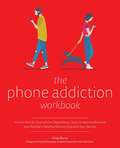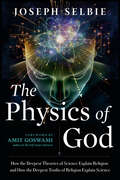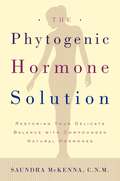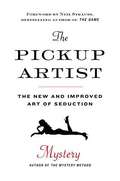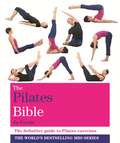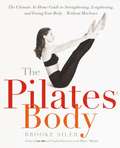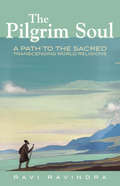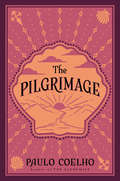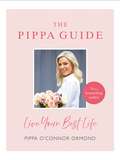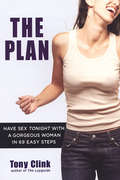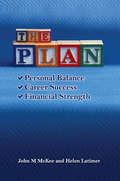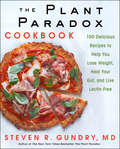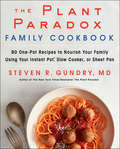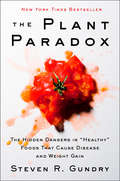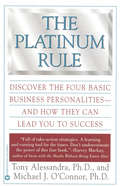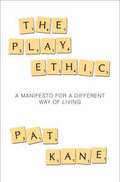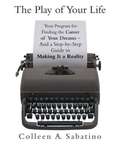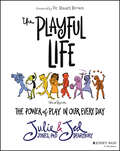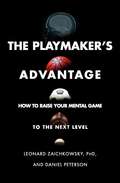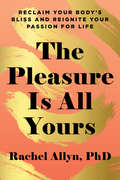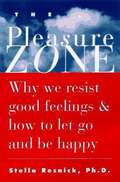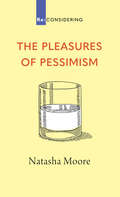- Table View
- List View
The Phone Addiction Workbook: How to Identify Smartphone Dependency, Stop Compulsive Behavior and Develop a Healthy Relationship with Your Devices
by Hilda BurkeStop scrolling and start living! Build healthier relationships between you, your smartphone and all your devices, including tips to reduce social media obsession, notification anxiety and other unhealthy habits.Your smartphone is a powerful device that has fundamentally changed your life—no doubt improving it in many ways. And while you don’t need to give up your smartphone completely, if your day to day is filled with endless, anxiety-inducing checking, swiping and liking, then you need this helpful, step-by-step workbook to take back control of your life.Phone addiction is similar to gambling addiction and substance abuse. Its consequences include stress, depression, insomnia, intimacy issues and more. Written by an experienced psychotherapist, couples therapist and former telecommunications industry insider, The Phone Addiction Workbook’s program offers the blueprint for understanding addictive behavior and how it controls you. Weekly charts, practical tips and interactive activities help you stop unhealthy behavior and make lasting change.
The Physics of God: How the Deepest Theories of Science Explain Religion and How the Deepest Truths of Religion Explain Science
by Joseph Selbie“An impressive and thought-provoking work . . . regarding the metaphysical mysteries of life, physical reality, and human consciousness. Highly recommended!” —Spirituality TodayScience and religion are often thought to be in conflict. But the contemporary fields of relativity, quantum physics, neuroscience, and more are in agreement with the transcendent phenomena described by saints, sages, and near-death experiencers. Today’s science actually provides profound insight into miracles, immortality, heaven, God, and transcendent awareness.The Physics of God describes the intersections of science and religion with colorful, easy-to-understand metaphors, making abstruse subjects within both science and religion easily accessible to the layman. This intriguing book:Pulls back the curtain on the light-show illusion we call matter.Connects string theory to religion’s transcendent heavens.Reveals the scientific secret of life and immortality.Demonstrates the miracle-making power of our minds to effect instantaneous physiological changes.Included in this revised edition is a new chapter on the physics of meditation and other updates.
The Phytogenic Hormone Solution: Restoring Your Delicate Balance with Compounded Natural Hormones
by Saundra MckennaThe Phytogenic Hormone Solution is a must-read for women suffering from hormone-related PMS, infertility, irregular cycles, fatigue, weight gain, and symptoms of perimenopause and menopause such as insomnia, headaches, and hot flashes. While conventional hormone replacement therapy can mitigate some of these problems, it is associated with several serious health risks.
The Pickup Artist: The New and Improved Art of Seduction
by Mystery Chris OdomThe world's greatest pickup artist is back! After the bestselling expose The Game pulled back the curtain on Mystery and his culture of professional pickup artists, he became an international phenomenon. Unfortunately, while it's no secret that Mystery's ideas are wildly effective, women have started to catch on. They've seen the show and heard the routines-so now it's time for the next level of game! With techniques honed over fifteen years of trial, error, and ultimate triumph, and following his hit VH1 reality series, the celebrated sensei is back with his latest living-large exploits and a new and improved playbook for the twenty-first-century playboy. As the book begins, Mystery and his crew have withdrawn to their swank Miami mansion to plot their next move. When a new student comes to stay at the house, Mystery draws him deep into the pickup-artist lifestyle and shows him an intimate portrait of the master of seduction. Mystery lays out a complete system of game, and unveils his latest (and fully field-tested) strategies and techniques. The Pickup Artist includes * a list of all the triggers that create-and destroy-attraction * a new way to approach strangers and start a conversation: microcalibrated openers * Mystery's most powerful humor technique, the Absurd-so you'll never run out of things to say again * a full chapter on physical escalation (touching, kissing, "making a move") * the solution to inner-game issues, for when you're not confident enough * and much, much more. Whether he's holding court with eager disciples in South Beach, hanging out with his crew of fellow super-seducers in Las Vegas, or partying it up in the Hollywood Hills, Mystery is never far from where the action is-and never fails to get a piece of it. Now it's your turn. Read The Pickup Artist and get into the game.
The Pilates Bible: Godsfield Bibles
by The Pilates Bibl Jo FerrisA complete illustrated guide to Pilates for beginners to advanced level.
The Pilates Body: The Ultimate At-Home Guide to Strengthening, Lengthening, and Toning Your Body--Without Machines
by Brooke SilerThe Pilates® method may be today's hottest exercise, but it has been endorsed by physicians for almost a century. Originally developed by Joseph H. Pilates to help strengthen and condition muscles, Pilates is the ultimate mind-body exercise for anyone who wants to tone, streamline, and realign their body without the bulked-up results of more conventional workout methods. Now, in The Pilates® Body, author Brooke Siler--one of the most sought-after personal trainers in the country and owner of New York's top studio for Pilates training, re: AB--provides a complete, easy-to follow program of Pilates exercises that can be done anywhere, anytime, and without machines. With step-by-step instructions, Siler guides the reader through the complete circuit of mat exercises, each of which is clearly illustrated by photographs, line drawings, and unique visualization exercises. With Pilates you will not only streamline your figure--you will dramatically improve your posture, flexibility, and balance, and enhance your physical and emotional well-being. The Pilates Body shows you how.
The Pilgrim Soul
by Ravi Ravindra"Wandering, one gathers honey," observes the Aitareya Brahmana. In this spirit Ravi Ravindra, renowned for his integration of physics and comparative religions, explores the heart of Buddhism, Christianity, and Hinduism to define a universal spiritual path that transcends any tradition. People with a pilgrim soul, he says, are open to a freedom from all that is known. They seek to practice mindfulness in each moment, so that washing the dishes or emptying the garbage becomes a sacred act; they seek to enter the dimension of eternity, realizing that the eternal is always present, right here, right now. Wisdom is the ability to act freshly in time while being anchored in eternity, says Ravindra. This deceptively simple small volume contains a wealth of wisdom for living that way.
The Pilgrim Soul
by Ravi Ravindra"Wandering, one gathers honey," observes the Aitareya Brahmana. In this spirit Ravi Ravindra, renowned for his integration of physics and comparative religions, explores the heart of Buddhism, Christianity, and Hinduism to define a universal spiritual path that transcends any tradition. People with a pilgrim soul, he says, are open to a freedom from all that is known. They seek to practice mindfulness in each moment, so that washing the dishes or emptying the garbage becomes a sacred act; they seek to enter the dimension of eternity, realizing that the eternal is always present, right here, right now. Wisdom is the ability to act freshly in time while being anchored in eternity, says Ravindra. This deceptively simple small volume contains a wealth of wisdom for living that way.
The Pilgrimage (Plus Ser.)
by Paulo CoelhoHere Paulo Coelho details his journey across Spain along the legendaryroad of San Tiago, which pilgrims have travelled since Middle Ages. On this contemporary quest, he encounters a Chaucerian variety of mysterious guides and devilish opponents and learns to understand the nature of truth through the simplicity of life. The Pilgrimage holds an important place in Paulo Coelho's literary canon. His first book, it not only paved the way for his phenomenal novel The Alchemist , but it also fully expresses his humanist philosophy and the depth of his unique search for meaning.
The Pippa Guide: Live Your Best Life
by Pippa O'Connor Ormond"I think anyone can do anything they want to do. I really believe that."Style icon and savvy businesswoman Pippa O'Connor Ormond believes that anything is achievable if you put your mind to it.In this honest and revealing guide to modern life, Pippa shares some of her personal moments, experiences and life lessons that have shaped her into the person she is today. From excelling at work, to making your house a home, styling your wardrobe and perfecting your beauty routine, nurturing family and friendships while promoting self-care, Pippa will reveal her most valuable tips for bringing positivity and happiness into your life."I'm always practising gratitude. No matter what you have in life, once you are grateful for it, it manifests more. 100%."
The Places That Scare You: A Guide to Fearlessness in Difficult Times
by Pema ChodronWe always have a choice, Pema Chödrön teaches: We can let the circumstances of our lives harden us and make us increasingly resentful and afraid, or we can let them soften us and make us kinder. Here Pema provides the tools to deal with the problems and difficulties that life throws our way. This wisdom is always available to us, she teaches, but we usually block it with habitual patterns rooted in fear. Beyond that fear lies a state of openheartedness and tenderness. This book teaches us how to awaken our basic goodness and connect with others, to accept ourselves and others complete with faults and imperfections, and to stay in the present moment by seeing through the strategies of ego that cause us to resist life as it is.
The Plan: How to Have Sex Tonight with a Gorgeous Woman In 69 Easy Steps
by Tony Clink"I'm going to walk you through one night as a stud."—Tony ClinkHE SHOOTS. HE SCORES. TONIGHT.This book is your secret weapon. When that girl stops you cold, go up to her, take her home, and spend the night doing exactly what you wanted to do the moment you saw her. Tony Clink, master seducer, shows you how you can be that guy—an unstoppable P.U.A. (Pick Up Artist), able to seduce any woman at any time . . . even tonight. Tips to get you in the same bed before the night is through:• Don't just stare—read her body.• It's how you touch her that counts.• Get rid of competition—even boyfriends.• A bar's the worst place to find tonight's conquest.• How to work through her posseBe the man with The Plan and stay UP all night.TONY CLINK, one of the world's greatest seducers, is the international bestselling author of The Layguide. He is also the webmaster of www.layguide.com.
The Plan: Personal Balance, Career Success, Financial Strength
by John M McKee and Helen LatimerThe Plan provides readers with a proven approach to creating a full and satisfying life. Applying the same time-tested methods used by many of the world's most successful organizations, readers will learn how to take control of their personal, career and financial lives with a straightforward step-by-step approach.
The Plant Paradox Cookbook: 100 Delicious Recipes to Help You Lose Weight, Heal Your Gut, and Live Lectin-Free (The Plant Paradox #2)
by Dr. Steven R Gundry, MDFrom renowned cardiac surgeon and acclaimed author Dr. Steven R. Gundry, the companion cookbook to New York Times bestselling The Plant Paradox, offering 100 easy-to-follow recipes and four-color photos. In the New York Times bestseller The Plant Paradox, Dr. Steven Gundry introduced readers to the hidden toxins lurking in seemingly healthy foods like tomatoes, zucchini, quinoa, and brown rice: a class of plant-based proteins called lectins. Many people are familiar with one of the most predominant lectins—a substance called gluten, which is found in wheat and other grains. But while cutting out the bread and going gluten-free is relatively straightforward, going lectin-free is no small task.Now, in The Plant Paradox Cookbook, Dr. Gundry breaks down lectin-free eating step by step and shares one hundred of his favorite healthy recipes. Dr. Gundry will offer an overview of his Plant Paradox program and show readers how to overhaul their pantries and shopping lists to make delicious, simple, seasonal, lectin-free meals. He’ll also share his hacks for making high-lectin foods safe to eat, including methods like pressure-cooking grains and peeling and deseeding tomatoes.With a quick-start program designed to boost weight loss and recipes for smoothies, breakfasts, main meals, snacks, and desserts, The Plant Paradox Cookbook will show readers of The Plant Paradox—and more—how delicious it can be to eat lectin-free.
The Plant Paradox Family Cookbook: 80 One-Pot Recipes to Nourish Your Family Using Your Instant Pot, Slow Cooker, or Sheet Pan (The Plant Paradox #5)
by Dr. Steven R Gundry, MDFrom the New York Times bestselling author of The Plant Paradox comes a guide to one-pot cooking for the whole family, with a special focus how to make the Plant Paradox program kid-friendly.Since the publication of The Plant Paradox in 2017, hundreds of thousands of people have embraced Dr. Gundry’s nutritional protocol—and experienced life-changing results. But most of Dr. Gundry’s readers aren’t cooking for themselves alone. “How can I extend this way of eating to my entire family? And is it safe for my kids?” are the questions he is most often asked.In The Plant Paradox Family Cookbook, Dr. Gundry reassures parents as he sets the record straight, providing an overview of children’s nutritional needs and explaining how we can help our kids thrive on the Plant Paradox program—a diet low in lectins. Dr. Gundry offers shocking evidence of how the Plant Paradox program is not only “safe” for kids, but also the best possible way to set them up for a lifetime of health and responsible eating. As research continues to bear out, a healthy microbiome—or “gut”—is the cornerstone of human health. The foods we eat at the beginning of our lives have a long-term impact on the makeup of our microbiome. Lectin-containing foods—such as grains, legumes, certain fruits and vegetables, and conventional dairy—damage it by creating holes in the gut wall and triggering the kind of systemic inflammation that lays the groundwork for disease. And yet, many of the foods we are routinely told to feed our children—think milk, whole grain bread, peanut butter—have an incredibly high lectin content.The Plant Paradox Family Cookbook includes more than 80 recipes that make cooking for a family a breeze. And since pressure cooking is the best and easiest way to reduce lectin content in foods like grains and beans, the majority of the quick and easy recipes are Instant-Pot friendly. From weeknight dinners to make-ahead breakfasts to snacks and even lunchbox-ready meals, The Plant Paradox Family Cookbook will help the whole family experience the incredible benefits of the Plant Paradox program.
The Plant Paradox: The Hidden Dangers in "Healthy" Foods That Cause Disease and Weight Gain (The Plant Paradox #1)
by Dr. Steven R Gundry, MDFrom renowned cardiac surgeon Steven R. Gundry, MD, the New York Times bestselling The Plant Paradox is a revolutionary look at the hidden compounds in "healthy" foods like fruit, vegetables, and whole grains that are causing us to gain weight and develop chronic disease.Most of us have heard of gluten—a protein found in wheat that causes widespread inflammation in the body. Americans spend billions of dollars on gluten-free diets in an effort to protect their health. But what if we’ve been missing the root of the problem? In The Plant Paradox, renowned cardiologist Dr. Steven Gundry reveals that gluten is just one variety of a common, and highly toxic, plant-based protein called lectin. Lectins are found not only in grains like wheat but also in the “gluten-free” foods most of us commonly regard as healthy, including many fruits, vegetables, nuts, beans, and conventional dairy products. These proteins, which are found in the seeds, grains, skins, rinds, and leaves of plants, are designed by nature to protect them from predators (including humans). Once ingested, they incite a kind of chemical warfare in our bodies, causing inflammatory reactions that can lead to weight gain and serious health conditions.At his waitlist-only clinics in California, Dr. Gundry has successfully treated tens of thousands of patients suffering from autoimmune disorders, diabetes, leaky gut syndrome, heart disease, and neurodegenerative diseases with a protocol that detoxes the cells, repairs the gut, and nourishes the body. Now, in The Plant Paradox, he shares this clinically proven program with readers around the world.The simple (and daunting) fact is, lectins are everywhere. Thankfully, Dr. Gundry offers simple hacks we easily can employ to avoid them, including:Peel your veggies. Most of the lectins are contained in the skin and seeds of plants; simply peeling and de-seeding vegetables (like tomatoes and peppers) reduces their lectin content.Shop for fruit in season. Fruit contain fewer lectins when ripe, so eating apples, berries, and other lectin-containing fruits at the peak of ripeness helps minimize your lectin consumption.Swap your brown rice for white. Whole grains and seeds with hard outer coatings are designed by nature to cause digestive distress—and are full of lectins.With a full list of lectin-containing foods and simple substitutes for each, a step-by-step detox and eating plan, and delicious lectin-free recipes, The Plant Paradox illuminates the hidden dangers lurking in your salad bowl—and shows you how to eat whole foods in a whole new way.
The Plateau Effect: Getting from Stuck to Success
by Bob Sullivan Hugh ThompsonThe Plateau Effect is a powerful law of nature that affects everyone. Learn to identify plateaus and break through any stagnancy in your life-- from diet and exercise, to work, to relationships. <P><P> The Plateau Effect shows how athletes, scientists, therapists, companies, and musicians around the world are learning to break through their plateaus--to turn off the forces that cause people to "get used to" things--and turn on human potential and happiness in ways that seemed impossible. The book identifies three key flattening forces that generate plateaus, two principles to guide readers in engineering a plateau's destruction, and three actions to take to achieve peak behavior. It helps us to stop wasting time on things that are no longer of value and to focus on the things that leverage our time and energy in spectacular ways. <P> Anything you want to do better--play guitar, make friends, communicate with your children, run a business--you can accomplish faster by understanding the plateau effect.
The Platinum Rule: Discover the Four Basic Business Personalities andHow They Can Lead You to Success
by Tony Alessandra Michael J. O'ConnorIn this entertaining and thought-provoking book, Tony Alessandra and Michael O'Connor argue that the "Golden Rule" is not always the best way to approach people. Rather, they propose the Platinum Rule: "Do unto others as "they'd" like done unto them". In other words, find out what makes people tick and go from there.
The Play Ethic: A Manifesto for a Different Way of Living
by Pat KaneThe Play Ethic explores the real meaning of play and shows how a more playful society would revolutionize and liberate our daily lives. Using wide and varied sources from the Enlightenment to Eminem, Socrates to Chaos theory, Kierkegaard to Karaoke, this book shows how play is fundamental to both society and to the individual, and how the work ethic that has dominated the last three centuries is ill-equipped to deal with the modern world.
The Play of Your Life: Your Program for Finding the Career of Your Dreams--And a Step-by-Step Guide to Making It a Reality
by Colleen A. Sabatino<p><i>Play of Your Life</i> is not just a how-to it is your own portable career-coach. While other books may promise to help you land the job of your dreams, Colleen Sabatino trumps that. She opens your eyes to the possibilities you've not yet imagined. The book offers a 2-step program. Part One guides readers through a series of engaging self-assessment quizzes and diagnostic steps to help each individual recognize their dream and translate that into a career path. Part Two is master class on the tactical steps toward making that dream a reality. <p>Colleen Sabatino is enjoying nationwide recognition as a career counselor. Her seminars and corporate consulting sessions are so popular that MBA programs are planning to adopt her book as part of their curriculum. From setting the stage, to crafting the life-script that will open the necessary doors, Sabatino's program affords the secret to becoming a star in your own life.</p>
The Playful Life: The Power of Play in Our Every Day
by Jed Dearybury Julie P. JonesDo you find yourself wanting more out of life? It&’s time to bring play to your every day Play is not just for kids! There are many reasons we need play in our lives. The Playful Life shows you why and how to bring more playfulness to all aspects of your life. You&’ll explore how to create meaningful, relevant, and fun experiences for yourself and others through both a playful mindset and playful behaviors. Through research and 20+ years of teaching children and adults, authors Dr. Julie Jones and Jed Dearybury have found that play is not only fun, it&’s essential to a full life. In this book, they share their knowledge and inspire you to reflect on the need for connection and joy for healthy living through play. This book will equip you with new definitions, ideas, and ways of thinking about play for your daily life. With a relaxed tone, comical banter, and real talk, the authors encourage new understandings about what play is and empower you to make more playful choices. If you strive to find balance, overcome stress, and enjoy each day through play—The Playful Life is a must read for your life journey! Learn what play means and why it&’s so essential to our everyday lives—at every age Discover the incredible benefits of play to your physical and mental health Get ideas for incorporating play into your everyday life at work, at home, or when you&’re out and about Begin healing past traumas and grow into the person you are meant to be—through play and playful living!Building on the popular book The Playful Classroom, this is a new and exciting take on what play does for all of us-- physically, socially, emotionally, and cognitively.
The Playmaker's Advantage: How to Raise Your Mental Game to the Next Level
by Leonard Zaichkowsky Daniel PetersonDiscover how to improve your mental game—the next frontier in sports training—no matter your age or experience and become the Playmaker or the decisive general on the court or field.Coaches search for it. Parents dream of it. Fans love it. Athletes want it. The Playmaker on any sports team possesses it: an elusive, intangible quality combining anticipation, perception, and decision-making skills. This quality raises their game above the competition and allows them to pass when no one else can, anticipate the movement of opponents, and avoid costly mental mistakes, thus holding the team together. Using today’s technology and tools, it is now possible to understand, assess, and train this sixth sense rather than just hope it magically appears. Now, for the first time, cognitive science research is revealing the secrets of the Playmaker’s keen sense of awareness. Just as tests of speed, strength, and agility have provided a baseline of physiological biomarkers, coaches can now capture cognitive metrics including attention, pattern recognition, anticipation, and the ability to take quick, decisive action during the chaos of competition. The Playmaker’s Advantage is a groundbreaking book that will educate athletes of all ages about this essential creative capability in an accessible, easy to understand method.
The Pleasure Is All Yours: Reclaim Your Body’s Bliss and Reignite Your Passion for Life
by Rachel AllynReconnect to your inner sense of pleasure and joy through embodiment practices, which put you in touch with the natural wisdom of your body and enhance your ability to connect with others. In this time of increased fatigue, loneliness, and anxiety, disconnection from our bodies and from each other is at the core of our personal pain and our collective suffering. Women in particular are rewarded for, and expected to participate in self-denial. By weaving together historical and cultural commentary, humorous and poignant anecdotes, and experiential tools backed by science, The Pleasure Is All Yours is a step-by-step guide to help you release barriers to receiving life&’s pleasures and deeper connections with others. In this timely guide, holistic psychologist, relationship and sex therapist, and yoga teacher Dr. Rachel Allyn introduces bodyfulness, an embodiment method she developed to help you to awaken into your body's own capacity for healing and deeper connection. Allyn explains how bodyfulness can connect you to four essential and overlooked types of pleasure—sensual, playful, lively, and erotic— which overlap in many ways, and helps you identify what can inspire your own pleasure in each category. Through bodyful activities such as breathing exercises, mindfulness, yoga, auditory release, and dynamic movements, this book helps you reunite with your inherent wisdom and soulful delight.
The Pleasure Zone: Why We Resist Good Feelings and How to Let Go and Be Happy
by Stella Resnick"When you are inspired by good feelings, there's no end to your energy." So says Dr. Stella Resnick, who has been concerned about how to help people stop focusing on what's wrong in their lives and start noticing what's right since 1978 when she wrote an article for New Age magazine that turned the therapy world on its ear. Now she has* distilled her years of work and collected extensive corroborative research to uncover the root of unhappiness-pleasure resistance. When people don't fully enjoy their lives and loves, it is usually because they have a fixed ceiling of how much pleasure they can tolerate. "There is an enormous untapped potential for pleasure in every one of us that has yet to be fully explored," she writes. While writers including Paul Pearsall, Deepak Chopra, Bernie Siegel, and Joan Borysenko have recently identified the benefits of pleasure, to a large extent they have been concerned with positive mental attitudes and visualizations. Dr. Resnick advances the exploration of pleasure further by linking optimism, physical health, emotional fulfillment in love, deeply gratifying sex, and positive aging to our ability to fully enjoy eight core pleasures. These are: primal pleasure, pain relief, the elemental pleasures of play and humor, and mental, emotional, sensual, sexual, and spiritual pleasure. In this ground-breaking work, Dr. Resnick discusses each core pleasure, pointing out subtle and not so subtle ways we deny ourselves and how each core pleasure is relevant to our health, emotional well-being, and interpersonal relationships. Complete with inspiring stories of people who have learned to reclaim pleasures they had cut themselves off from, each chapter concludes with a set of simple personal experiments designed to aid readers in gaining skill at enjoying that pleasure more completely. The Pleasure Zone is for anyone wanting to maintain a lifestyle based on being drawn rather than driven, and on fully celebrating all the pleasures of a lifetime.
The Pleasures of Pessimism (Re: CONSIDERING)
by Natasha MooreRe:CONSIDERING invites you to look at what’s familiar from an unfamiliar angle. To consider how we consider things – and how to do it better.Pandemic, supervolcano, late capitalism, transhumanism, populism, cancel culture, the post-antibiotic age, the gig economy, the surveillance state, the cascading effects of climate change …Whatever the specifics, do you ever feel like things are going off the rails - or are just about to?If you’ve read the news, watched a zombie movie, or gotten into an argument on Twitter lately, the answer is probably yes.And you’re not alone.What makes us such apocaholics?What’s so appealing about Armageddon? What are the pleasures - and also the perils of our pessimism?
